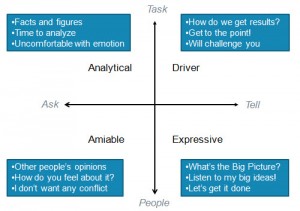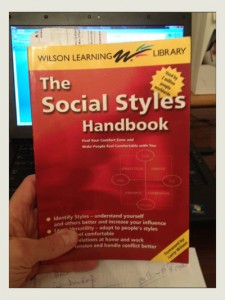Leveraging Personality Types in your interactions
 Change the way you look at the world by changing your approach leads to better interactions and better results.
Change the way you look at the world by changing your approach leads to better interactions and better results.
Have you ever been in a situation where the person you are interacting with makes no sense to you? They seem totally irrational and frustrating?
You may be having a clash of personality types.
Personality type classification is another of the pseudo-scientific methodologies meant to quantify the messiness of human behavior into rational piles. In this way, the intent is, that you can determine how your behavior and your style of interacting, meshes with people of different styles and behavior patterns.
Why do you care? You care because in life and in business you have to interact with all different types of people. Some of them you will find very frustrating and you won’t know why until you realize that their personal style is at odds with yours.
You benefit in two ways. First you finally understand why they are so hard for you to interact with. Second, you can modify your approach to mesh with theirs and vastly improve the interaction. In this way you can have out-of-the-box strategies for the different personality types that you encounter and it will vastly improve not only your experience but your effectiveness in these interactions.
There are many flavors of these personality typing methodologies. One of the first and most famous is the Myers Briggs personality test. This was based on Carl Jung’s work in the 1920’s. Myers and Briggs created a questionnaire that people could take to determine their personality type. They came up with 16 different possible personality types and talked through how each interacted with each other.
 A more recent rendition of the personality type methodology is laid out in a great little book that the Zen Runner lent me last week from the Wilson Learning Library called The Social Styles Handbook.
A more recent rendition of the personality type methodology is laid out in a great little book that the Zen Runner lent me last week from the Wilson Learning Library called The Social Styles Handbook.
This is a much simpler and much more practical adaptation of the personality type method. They break it up into 2 main axis and 4 possible social styles.
I have included a rendition of the graphic of this quadrant with this article. The vertical axis is Task Based vs People Based. The horizontal axis is Ask vs Tell.
There are 4 social styles based on this definition.
Starting in the upper right is the “Driver” personality type. The driver is Task based and Tell based. Drivers have an outward focused, task driven social style. You recognize these people. Many executives that I work with are drivers. They are brief and to the point and are focused on results. These are the people who stop you 5 minutes into your presentation and ask you to get to the point.
The upper left quadrant are the Analytics social style. These folks are still task based but are introverted. You will also recognize this type. They are the ones who want all the numbers to add up and aren’t happy if they are forced to make a decision without all the facts. Many of the technical folks you interact with are analytics.
The lower left quadrant are the ‘emotives’. The emotives are Ask based and People based. Again, these people will be obvious to you as well. They use words like ‘feel’ and are very concerned with people’s feelings and need to have a consensus and don’t like conflict.
The final, lower right hand quadrant contains the “Expressives’. Expressives are outward focused tellers and people persons. They are the big picture people who love to paint the vision. They communicate well but sometimes have trouble with the details.
The first thing you need to do is to figure out what social style or personality type you are. Then you can build strategies for interacting with others with different styles.
For example, since I’m an expressive, analytical people drive me nuts and if I’m not careful I’ll drive them nuts because we have no style traits in common. I don’t care about the details because I’ve got a vision and I’ll see them as a bunch of slow, dimwitted, dullards slowing me down. They will, on the other hand, want to verify all the details and will see me as a careless, flighty, blowhard bull-shitter.
Since I know about social styles when I’m confronted by an analytic I’ll slow down and prepare myself to tell them the same thing 3 or 4 times until they are comfortable with it. Or, better yet, I’ll match them up with someone more analytical on my team.
That is the big learning from this exercise. It’s first to understand and then to put that understanding to use by changing your approach. By changing your approach you can get what you want with less aggravation.
The same holds true for these methodologies as all the others that try to quantify the messy non-quantifiable nature of human behavior. There is no pure A or B. There are shades of grey. You may find that your social style is on the line and you exhibit attributes of different quadrants.
Be careful. Use the information to improve the quality of your interactions and to gain insights into the seemingly irrational behavior of others, but understand that nothing is absolute.
I quite enjoy these personality types and social styles exercises. It is quite worth it for no other reason than it provides a fresh framework for you to approach some of the stickier, more intractable challenges of human behavior in a social settings.
Chris,


Thanks for sharing this Chris. I do a lot of work with Myers Briggs but like that this provides an even simpler framework to use when interacting with people.
Cool – Feel free to provide feedback – either way.
We are all still learning.
C-,